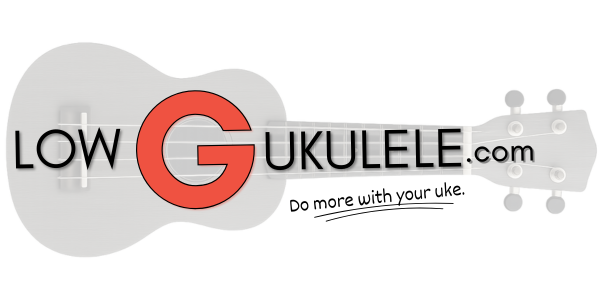This article, “The C Shape Chord,” is the second in my CAGED Foundations series. Be sure to read the Introduction article and hop over to the Low G Knowledge Base to see all articles in the series as well as other helpful tools for learning low G ukulele.
There’s a downloadable PDF with all of the chord charts from this article at the end of the second page.
Today we are looking at the humble C major chord – that one finger marvel that we all learn when we first pick up a ukulele. Here it is in all of its glory:

A major chord is made of the 1st, 3rd, and 5th notes of the major scale, also known as the root, the major third, and the perfect 5th. For the C major chord, those notes are:
C D E F G A B 1 2 3 4 5 6 7
Make the Ukulele C Shape Moveable
To make the C major chord moveable, we need to ignore the notes and only think about the intervals, or the numbers behind the notes – that 1, 3, and 5 I just mentioned. Here’s the chord again but with numbers for the intervals instead of the note names:

Now let’s turn this shape into something you can move around and place anywhere on the neck:

This is now the C shape major chord. We call it a “C shape” out of convenience, but really it can be any major chord – you just have to put the 1’s on the root note of your choice. You’ll often hear this referred to as a “major chord with a root on the A (or C) string.”
You play this shape by placing your ring finger on the fret of your choice on the A string and then barring across all four strings with your index finger three frets up from your ring finger.
For those who find this barre shape too challenging, jump down to the “Make These Chords Easier to Play” section below.
Make the Ukulele C Shape Part of a Scale
Chords are more useful if you understand where the other notes of the parent scale fall on the fretboard. Knowing the relationship between chords and scales allows you to modify the chord without memorizing every conceivable shape and compose/arrange melodies in the key of the chord with ease.
Here’s what the C shape major scale looks like:

And here’s the moveable major chord shape within the scale:

Notice that I’ve shifted these up a fret from most of the previous chord diagrams. These charts are actually showing the C# major scale and chord. All of the notes wouldn’t fit in this pattern if I left it in C.
Just remember: Wherever you put the 1, you are playing the major scale of that note. And within that scale, you can find all of the possible chords.
Chords live inside of scales. This is an important idea to wrap your head around. We’ll explore it a lot more as we learn to modify the C shape later in this article.
Make the Ukulele C Shape Minor
The chord modification we use most often is the minor. We use it so often, that we don’t think of it as a modification of the major. We think of it as its own, independent thing, even though they are closely related.
We get a minor chord by flatting the 3rd of a major chord, making the three notes of the minor chord the root, the minor 3rd (b3), and the perfect 5th.
Here’s what that looks like on the neck as a moveable shape related to our C shape:

There’s that pesky barre again. For the moveable C minor shape, you’ll want to barre the CEA strings with your ring finger and then grab the G string three frets up with your index finger.
If you can’t manage these barres and stretches, don’t worry, because I’m about to show you how to…
Make These Chords Easier to Play
You may have noticed that the barres for both the C major shape and C minor shape contain all three notes of their respective triads (135 and 1b35). The single note three frets up/down from the barre is a repeated note.
So to make these shapes easier to play, you can just leave out the repeated note altogether, leaving you with these moveable triad shapes:


You can play these either by barring across the three strings with the finger of your choice or using three fingers to fret the three strings individually, whatever is more comfortable for you.
Continue to the next page to learn how to further modify the C Shape…

Leave a Reply